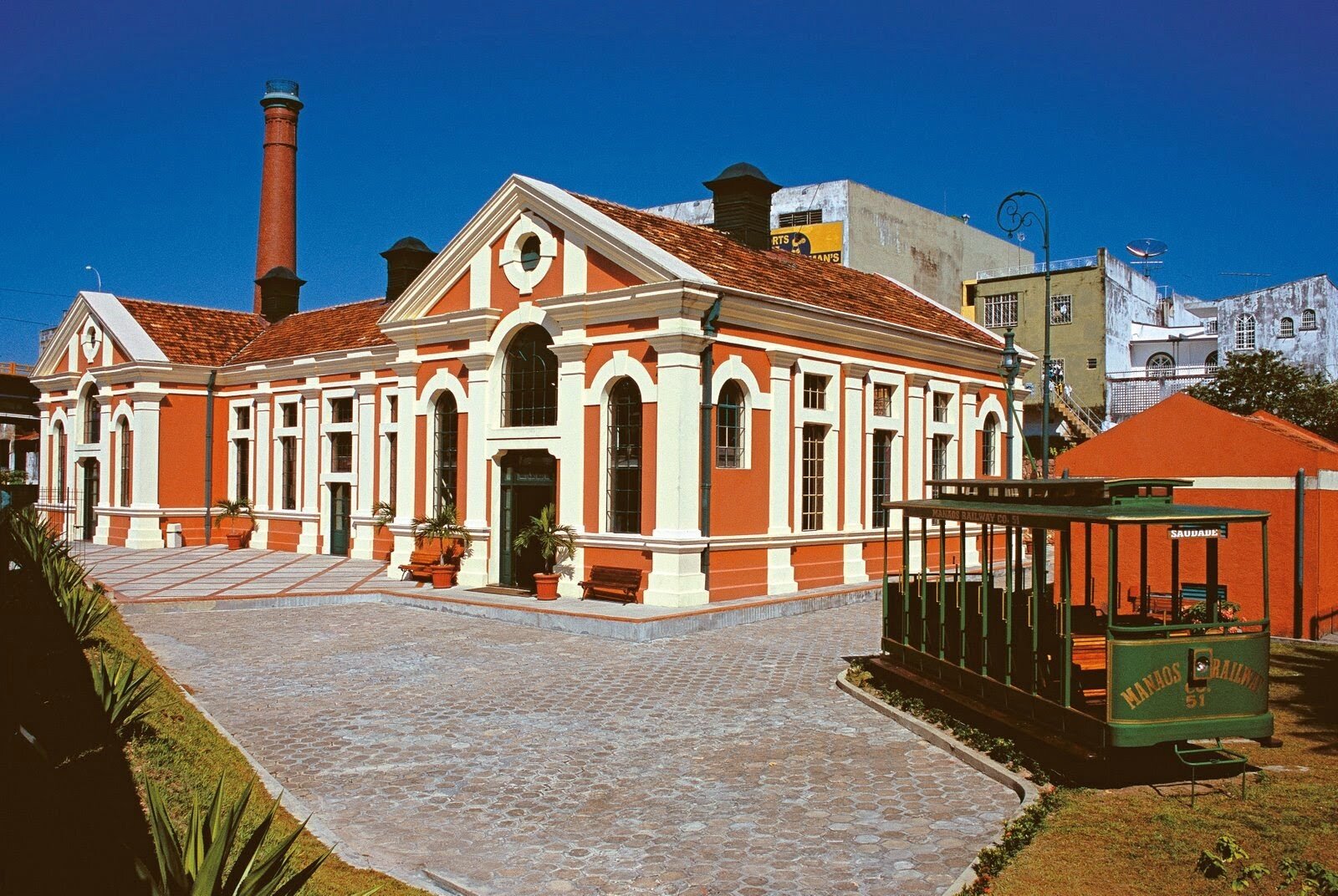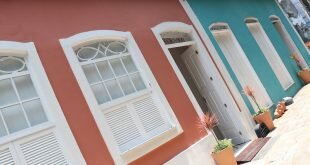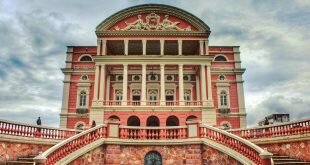Heritage Heritage in Amazonas
Partial aerial view of the Historic Center of Manaus
The city of Manaus is located on the left bank of the Negro River and is the Capital of the State of Amazonas, located in the northern region of Brazil. The city has a privileged geographical position, it is located about 3.490 kilometers from the federal capital, Brasília. It is also the capital of the largest state in Brazil. Economically, Manaus is the sixth richest city in Brazil, according to IBGE 2012, in addition, it has the second largest metropolitan region in the north of the country and twelfth in Brazil, with about two million inhabitants is also among the cities with the largest population, being in eighth place in terms of human contingent of the country.
Manaus is inserted in the middle of the Amazon Forest, rich in biodiversity, responsible for twenty percent of all the fresh water on the planet. It is an exuberant place that contains a diversified stock of natural resources, besides undeniable artificial resources, among which those built at the time of the rubber boom stand out, that allied to the cultural manifestations of the Amazon people, with its cultural diversity (material and immaterial), that bring in its mystical universe, the beliefs, among others, are basic raw material to think about the full tourist development of this city.
History
Manaus was founded in 1669 from the fort of São José da Barra do Rio Negro, the seat of the Captaincy, and the headquarters of the Province. The city's name comes from the Manaós tribe, inhabitants of the region, which in the indigenous language means Mother of the Gods. Between 1580 and 1640, a time when Portugal and Spain were under one crown, the European settlement in the Amazon began. The occupation was slow because it was not easy to obtain short-term profits, access was difficult, and the existence of riches such as gold and silver was unknown. In 1669, the construction of Forte São José da Barra do Rio Negro began, built of stone and mud, with four cannons, to ensure the dominion of the Portuguese crown in the region.
With the proclamation of the Republic, in 1889, Manaus became the capital of the State of Amazonas, a time when rubber, the raw material for world industry, was increasingly in demand. Amazonas, as the main producer, oriented its economy to meet the demand, in the so-called Golden Period of the Rubber (1880-1914). The city began to receive Brazilians from various parts of the country, in addition to Portuguese, English, French, Dutch, Jews, Italians, Spaniards, among others. This demographic growth generated significant changes in the city. Starting in 1892, the government of Eduardo Ribeiro elaborated a plan to coordinate the growth. Manaus gained collective electric tramway transport, telephony, electricity and piped water, in addition to a floating port, which began to receive ships of various flags.
The rubber metropolis, in the 1900's, had a population of approximately 40 thousand inhabitants, in its straight and long streets, paved with granite and lino stones imported from Portugal, squares and exuberant gardens, fountains, monuments, besides hotels, casinos, banking establishments, palaces, and all the refinements of a modern city with European style.
Manaus became one of the wealthiest and most modern cities in Brazil at the time, and was one of the first to implement electric street lighting and build an electric streetcar system. Such wealth was reflected mainly in the construction of imposing mansions and monuments that became architectural icons in the city, such as the Adolpho Lisboa Municipal Market, Palace of Justice, Provincial Palace, Rio Branco Palace, Mocó Water Reservoir, Public Library, São Sebastião Church, Nossa Senhora da Conceição Church (Matriz), Customs Building, the famous Amazonas Theater, among others.
Manaus was known at the time as the "Paris of the Tropics", due to the fact that Paris/France was considered a model of civilization in the 19th century to be followed and copied all over the world. Therefore, Manaus has great traces of a jewel of the tropical belle époque nestled in the middle of the Amazon jungle.
In 1910, Manaus was still living the euphoria of high rubber prices, when it was surprised by the strong competition from natural rubber planted and extracted from rubber plantations in Asia, which invaded the international markets. It was the end of the dominance of natural rubber exports from the Amazon and the beginning of economic agony for the region. A situation generated by the illicit shipment of thousands of rubber tree seedlings (hevea brasiliensis) by the English who sent them to the botanical garden in England and from there spread them to their colonies in Asia.
Monuments, buildings and public spaces listed in the Amazon
Currently, the historical buildings, for the most part, are located between Avenida Eduardo Ribeiro, Avenida Sete de Setembro, and Rua Leonardo Malcher. From the colonial core, only the urban layout remains, organic in counterpoint to the planned layout, still in the 19th century. In architecture, a good amount of eclectic buildings are still preserved.
The historic center of Manaus in the 21st century presents an urban portion formed by buildings from the golden period mixed with modern buildings. Even though fragmented, Manaus still has a vast and diversified architectural vocabulary, with representation of all the eclectic currents, and the verticalization still does not compromise the perception of the space created in theBelle époque. Thus, according to Iphan's opinion, the city can be seen as an urban space composed of monuments, current architecture and public open areas, forming a set that celebrates and represents the eclecticism in the north of the country, which justifies the request for registration in the Livro de Tombo Histórico (Historical Tomb Book) and in the Livro de Tombo Arqueológico, Etnográfico e Paisagístico (Archeological, Ethnographic and Landscape Book).
The Advisory Council of the Cultural Heritage, meeting at the headquarters of the Institute of National Historical and Artistic Heritage - Iphan, in Brasilia, approved on January 26, 2012, the listing of the Historic Center of Manaus / AM. The area represents one of the greatest testimonies of a unique economic phase in Brazil: the rubber period. Cities like Manaus, Belém/PA and Rio Branco/AC, are examples of the occupation and development of the Northern region, when the exploitation of latex provided the increment of industrialization on a global scale.
Downtown Manaus has more than 1,600 buildings listed as part of the City's Historical Heritage along streets and avenues such as Sete de Setembro, Epaminondas, Joaquim Nabuco, Leonardo Malcher, and Miranda Leão. The boundaries of the Historic Center of Manaus begin at the igarapé dos Educandos with the Rio Negro up to the igarapé de São Vicente, passing through the Rua José Clemente up to the Rua Luiz Antony to the igarapé da Castelhana going to the Avenida Constantino Nery, Avenida Álvaro Maia up to the Rua Major Gabriel, passing through the Rua Ramos Ferreira up to the igarapé do Mestre Chico and returning to the igarapé dos Educandos and Rio Negro.
The toppling of the Historic Center of Manaus is part of Iphan's policy to expand the protected areas throughout the country, with emphasis on the North and Midwest regions. In the capital of Amazonas, the area between the Rio Negro riverfront and the Teatro Amazonas surroundings is the one that still maintains the symbolic and dense aspects of artistic and constructive accomplishments. The preservation of this nucleus, which forms the urban heart of the city, guarantees the maintenance of its unique and integral heritage, and includes Manaus among the historical cities of Brazil.
In Manaus only four monuments have been listed federally, by the Ministry of Culture/IPHAN (Institute of National Historic and Artistic Heritage), which are:
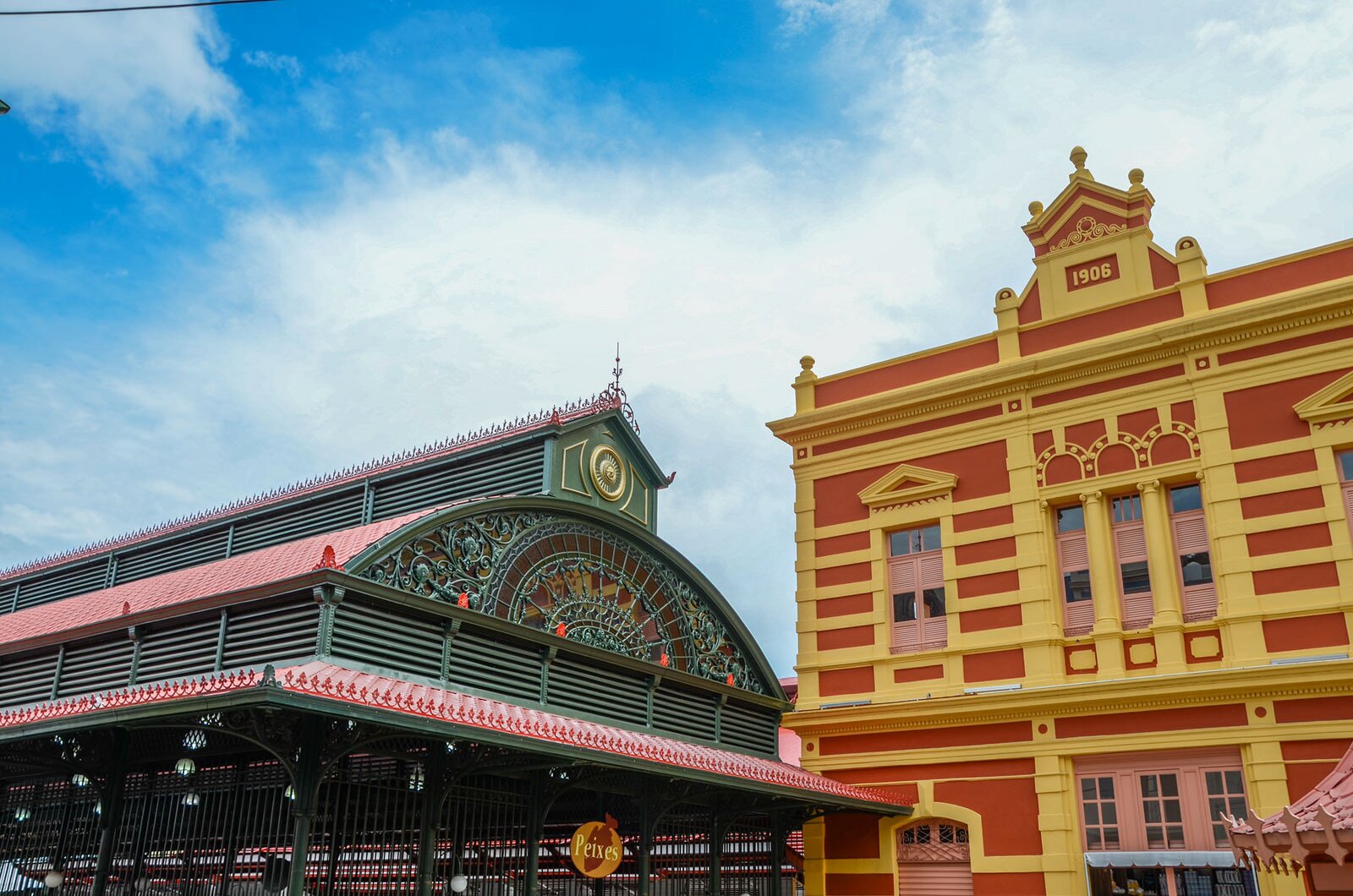
Adolpho Lisboa Municipal Market
One of the most important centers of commercialization of regional products in Manaus, it was built during the rubber boom period. As it is one of the main examples of iron architecture without similar in the world, it was listed in 1987 by Iphan. On the flag of the main gate there is a carved tablet with the name Adolpho Lisboa who, at the time of construction, was mayor of the city of Manaus. Later Lisboa gave the name to the market.
- Process n. 1179/85 - Livro do Tombo Histórico (Book of Historical Records), on July 1st, 1987.
- Registration number: 514.
- Fine Arts Tombo Book, fl. 11.
- Registration Number: 584.
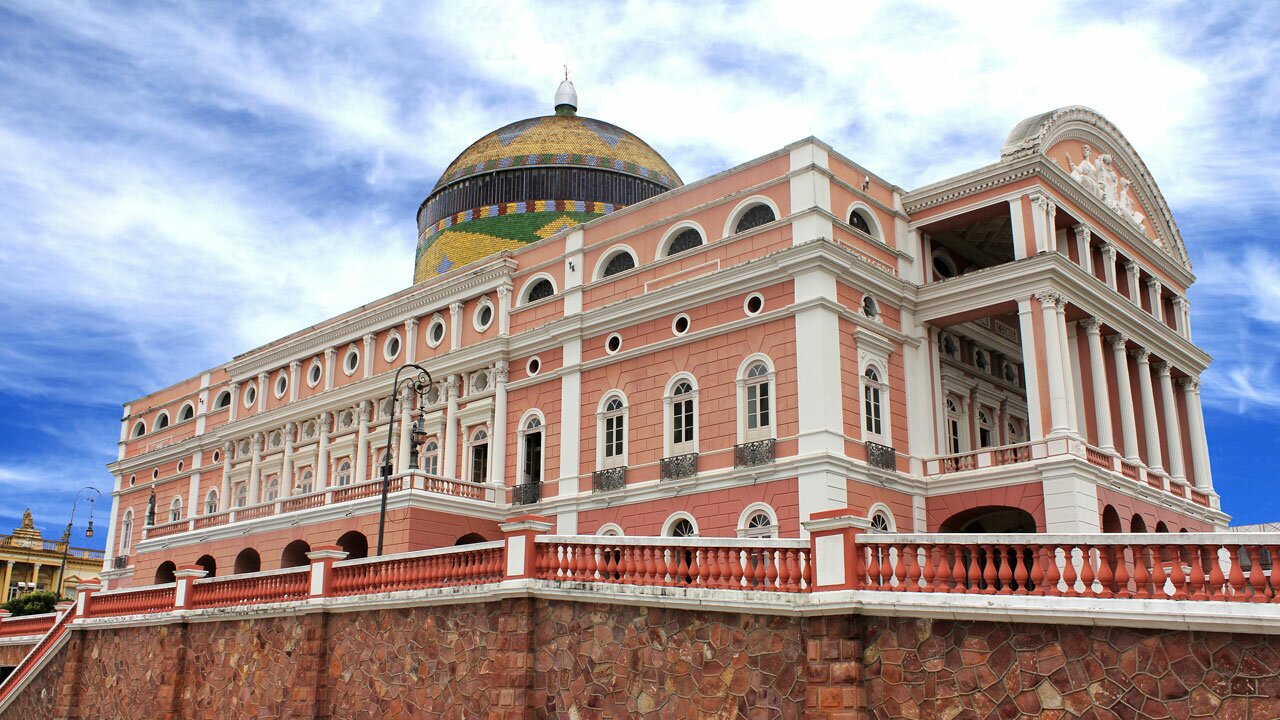
Amazonas Theater
Inaugurated in 1896, it is the most significant expression of the region's wealth during the Rubber Cycle. The city was one of the most prosperous in the world, driven by the wealth coming from rubber latex, a product highly valued by European and American industries. Therefore, it needed a place where foreign show companies could perform and the construction of a theater was a requirement of the time. The architectural project chosen was the one by the Portuguese Cabinet of Engineering and Architecture of Lisbon and today it is the main architectural cultural heritage of Amazonas, listed as historical heritage by Iphan, in 1966.
- Processo n. 693/63 - Historical Registration Book - fl. 63.
- Registration Number: 390 - December 20, 1966.
- Inaugurated in 1896.
Water tank / Mocó Reservoir
A magnificent work in neo-Renaissance style, it was inaugurated in 1899 during the rubber boom period. The reservoir, which covers an area of approximately one thousand square meters, was planned and built with the objective of solving the water supply problems that were affecting the city at the end of the 19th century. It stands out for the magnificence of its internal structure - all made of iron imported from England - which supports two huge metallic tanks, installed in the upper part of the building. Protected by IPHAN in 1985, the Mocó Reservoir still supplies part of the city of Manaus.
- Process n. 1127/84 - Livro de Tombo Histórico (Register of Historic Deeds), pg. 88, on April 24, 1985.
- Fine Arts Tombo Book - Decree Law n. 25, pg. 9.
- Registration Number: 569 - April 24, 1985.
Architectural and Landscape Set of the Port of Manaus
In the port of Manaus, a city bathed by the Negro River, besides the masonry pier, a pier was built on cylindrical iron buoys to float independently of the river level. The way of thinking of the early 20th century architecture is well represented in the port. Iron appears with its own formal solutions - warehouses with corrugated fence plates, road-way on floating buoys. In the Customs and Administration buildings the iron structure is hidden under masonry fences, with elements alluding to past styles. Architectonic and landscape set - Port facilities located at Rua dos Barés, Rua Marquês de Santa Cruz, Rua Monteiro de Souza, Rua Vivaldo Lima, Rua Taqueirinha, Rua Visconde Mauá, Rua Praça Oswaldo Cruz, Rua Marquês de Santa Cruz, Rua Monteiro de Souza, Rua Vivaldo Lima, Rua Taqueirinha, Rua Visconde Mauá, Praça Oswaldo Cruz, and Rua Ilha de São Vicente, as well as the buildings located at Avenida Eduardo Ribeiro nº 02 - Alfândega.
- Process n. 1192/86.
- Registration Number: 100 - Livro do Tombo Arqueológico, Etnográfico e Paisagístico, pg. 49, on October 14, 1897.
- Registration Number: 589
- Fine Arts Tombo Book
- Decree Law n. 25, from November 30, 1937.
There are, however, the tombamentos at the state level and that are part of the Heritage of Amazonas, such as:

Dom Pedro II Square
Inaugurated in 1897, it was initially surrounded by railings, removed in 1907 and installed at the southern entrance of the Adolpho Lisboa Market, where they remain until today. It has an iron bandstand, concluded in 1888, made by the English company Francis Morton & Cia. Limited Engineer, from Liverpool, and an iron fountain. The square was built over an Indian cemetery, discovered at the end of the 19th century, and registered as an archeological site in the 1960s.
Municipal Clock
Built in 1929, with the project author being the Amazonian Coriolano Durand, it has a neoclassical style and Swiss origin gears. It has two dials. In one of them there is the Latin inscription Vulnerant omnes, ultima necat, which means "All wound, the last one kills".
- Decree n. 11.197 - June 14, 1988, D.O.E. June 16, 1988.
Amazon Academy of Letters
Founded in 1918, it worked, initially, at the Instituto Universitário de Manaus. The donation of the current building occurred in 1935, belonging to the eclectic repertoire.
- Decree n. 5218 - October 30th 1980, D.O.E. October 3rd 1980.
Benjamin Constant Institute
Construction of the late nineteenth century, in eclectic style, received various uses: Baron of São Leonardo's palace, botanical museum, orphanage Benjamin Constant Institute. Nowadays it is a unit of the Centro de Educação Tecnológica do Amazonas.
- Decree n. 11.190 - June 14th 1988, D.O.E. June 16th 1988.

State Public Library
Built between 1905 and 1910, on the land where the Public Stables used to be, it suffered a fire in 1945, losing almost all its collection and the south wing of the building, which was rebuilt and reopened two years later. It was designed by Para architect José Castro de Figueiredo. In its eclectic style architecture, with classic elements predominating, the internal staircase stands out, made of wrought iron in lace, from Liverpool, England.
- Decree n. 11.033 - April 12th 1988, D.O.E. April 14th 1988.
São João Batista Cemetery
The acquisition of the first lands began in 1890 and inauguration occurred in 1891. In 1905 were built the walls facing the Avenida Álvaro Botelho Mais and Rua Major Gabriel, including its iron gates, of Scottish origin. The other walls date from the early 1920s. It has a chapel in neo-Gothic style, inaugurated in 1906 and remodeled in 1915. It is located in the area surrounding the Mocó Reservoir.
Chaminé Arts Center
This building used to be the old sewage treatment plant, under the responsibility of the English company Manaos Improvements Limited Company. Its construction was concluded in 1910. In 1993, it became the Chaminé Arts Center.
- Decree n. 15.483 - June 17th 1993, D.O.E. June 18th 1993.
Post and Telegraph Agency Building
Built in the early twentieth century to house the Marius & Levy firm, the eclectic style building has ceramic coating and exposed bricks in all facades. The Post and Telegraph company has been in the building since 1921.
- Decree n. 11.200 - June 14th 1988, D.O.E. June 16th 1988.
Law School
In this building worked the School Group Silvério Nery and the School Group Nilo Peçanha. From 1934 on, the Manaus Juridical and Social Sciences College was installed, name changed to Amazon Law College in 1936, which was transferred to the University Campus in 2004. In eclectic style, the second floor was built in the reform that took place between 1936 and 1938.
- Decree n. 11.188 -14th June, 1988, D.O.E. June 16th, 1988.
Schools
Euclides da Cunha School Group (dated 1896), Barão do Rio Branco School Group (former Portuguese Consulate, in 1943 became the school headquarters), and José Paranaguá School Group (opened in 1895, currently houses the State Board of Education).
- Rio Negro Palace: Decree n. 5218 - October 30, 1980, D.O.E. of October 03, 1980.
- Palace of Justice: Decree n. 5218 - October 30, 1980, D.O.E. of October 03, 1980.
- Instituto Geográfico e Histórico do Amazonas, Museu Chrisanto Jobim and all its collection: Decree n. 5218 - October 30, 1980, D.O.E. of October 03, 1980.
- Architectural Complex of the Heliodoro Balbi Square: Decree n. 11.034 - April 12, 1988, D.O.E. of April 14, 1988.
- Headquarters of the Amazonas Military Police General Command, Tiradentes Museum and its collection: Decree n. 11.035 - April 12, 1988, D.O.E. of April 14, 1988.
- Santo Antonio Church (Podre Diabo): Decree n. 11.036 - April 12, 1988, D.O.E. of April 14, 1988.
- Nossa Senhora dos Remédios Church: Decree n. 11.037 - April 12, 1988, D.O.E. of April 14, 1988.
- Saint Sebastian Church: Decree n. 11.038 - April 12, 1988, D.O.E. of April 14, 1988.
- Nossa Senhora da Conceição Cathedral Church (Matriz): Decree n. 11.039 - April 12, 1988, D.O.E. of April 14, 1988.
- Benjamin Constant Bridge: Decree no. 11.199 - June 14, 1988, D.O.E. June 16, 1988.
- Grupo Escolar Nilo Peçanha: Decree n. 11.185 - June 14, 1988, D.O.E. of June 16, 1988.
- Castelhana Station: Decree n. 11.187 -14 June 1988, D.O.E. of 16 June 1988.
- José Paranaguá School Group: Decree n. 11.189 - June 14, 1988, D.O.E. June 16, 1988.
- Saldanha Marinho School Group: Decree n. 11.191 - June 14, 1988, D.O.E. June 16, 1988.
- Euclides da Cunha School Group: Decree n. 11.192 - June 14, 1988, D.O.E. June 16, 1988.
- Barão do Rio Branco School Group: Decree n. 11.193 - June 14, 1988, D.O.E. June 16, 1988.
- Ribeiro da Cunha School Group: Decree n. 11.194 -June 14, 1988, D.O.E. of June 16, 1988.
- Central State Penitentiary "Des. Raimundo Vidal Pessoa": Decree n. 11.195 -June 14, 1988, D.O.E. of June 16, 1988.
- Centro de Convivência do Idoso L.B.A.: Decree n. 11.196 -14 June 1988, D.O.E. 16 June 1988.
- Water and Sewage Treatment Station: Decree n. 11.186 - June 14, 1988, D.O.E. of June 16, 1988.
The Central Office and its façade (Taqueirinha Street, No. 125), Administrative Sector (Governador Vitório Street, No. 121), Operations Sector - former Treasury Building (Monteiro de Souza Street, S/N), Port Museum (Vivaldo Lima Street, No. 610), Bernardo Ramos Street property Nos. 69 and 77, former Electrical Traction House (Marquês de Santa Cruz Street, S/N) were also registered as Heritage Buildings, Road-Way and the fire pump, and Warehouses No. 3, 4, 5, 10, 15, 18 and 20, Paço da Liberdade (City Museum), Coreto and Chafariz of Praça Dom Pedro II and Praça IX de Novembro, among others.
The Organic Law of the Municipality of Manaus, through Article no. 235: Paragraph 2: The historical site of the city is the stretch between Sete de Setembro Avenue until the Rio Negro riverside, including Manaus Floating Port, Torquato Tapajós, 15 de Novembro and Pedro II Squares, Rua da Instalação, Frei José dos Inocentes, Bernardo Ramos, Joaquim Nabuco Avenue in all its extension, Visconde de Mauá, Almirante Tamandaré, Henrique Antony, Lauro Cavalcante and Governador Vitório.
 Manaus Agile Amazonas' tourism and culture
Manaus Agile Amazonas' tourism and culture